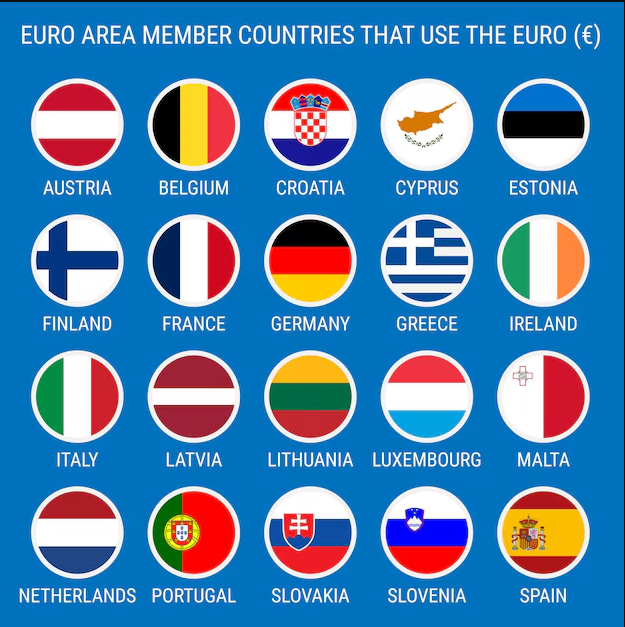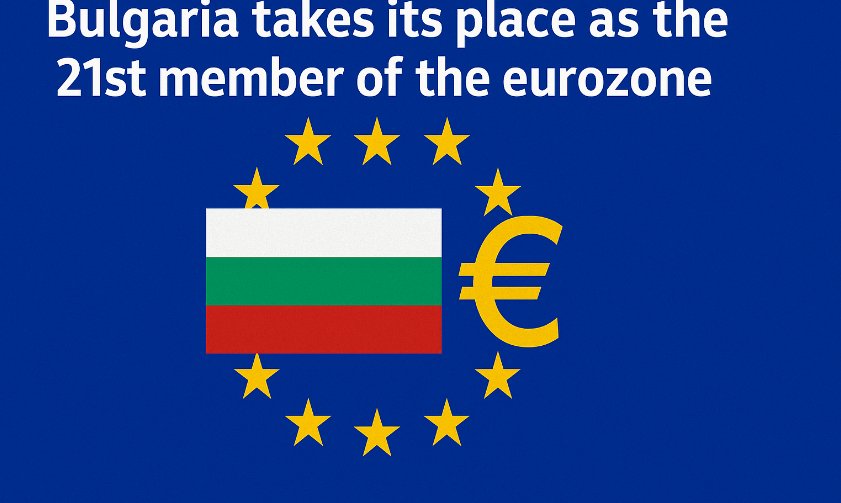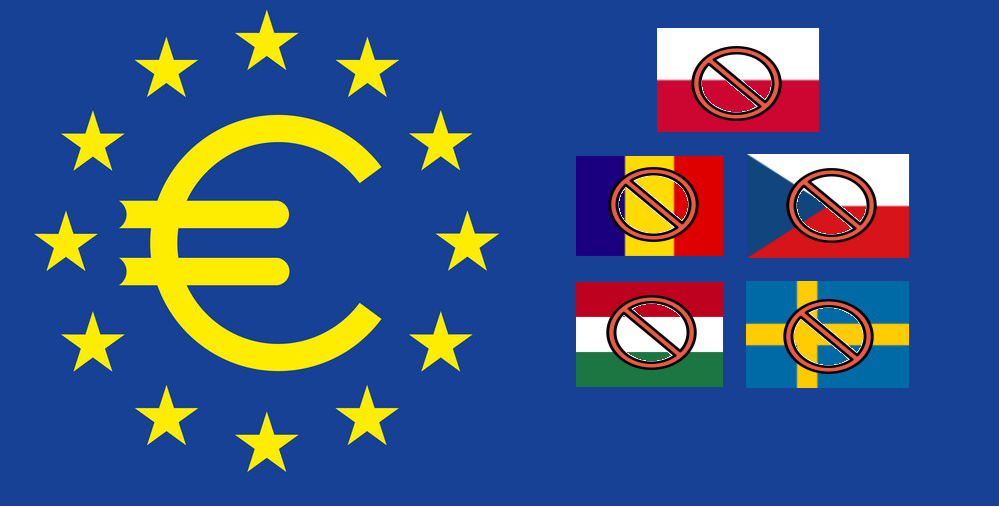As of 2025, 20 European Union countries officially use the euro (EUR) as their national currency. Bulgaria is approved to join the eurozone on 1 January 2026, making 21 in total.
Introduced in 1999 as an electronic currency and later in 2002 as physical notes and coins, the euro has become a symbol of economic integration and stability among its adopters.
Below, you'll find a breakdown of eurozone members, non-EU users, and countries that still do not use the euro, along with what's coming next.
What Countries Use the Euro? Eurozone

Eurozone Members
These 20 EU member states have fully adopted the euro and operate under the monetary policy of the European Central Bank (ECB):
| # |
Country |
Euro Adopted |
Notes |
| 1 |
Austria |
1999 (cash 2002) |
Founding member, full adoption |
| 2 |
Belgium |
1999 (cash 2002) |
Founding member |
| 3 |
Croatia |
2023 |
Latest country to join |
| 4 |
Cyprus |
2008 |
Southern Europe, small open economy |
| 5 |
Estonia |
2011 |
Baltic state |
| 6 |
Finland |
1999 (cash 2002) |
Founding member |
| 7 |
France |
1999 (cash 2002) |
Founding member, includes overseas territories |
| 8 |
Germany |
1999 (cash 2002) |
Founding member, largest Eurozone economy |
| 9 |
Greece |
2001 (cash 2002) |
Joined in 2nd wave |
| 10 |
Ireland |
1999 (cash 2002) |
Founding member |
| 11 |
Italy |
1999 (cash 2002) |
Founding member |
| 12 |
Latvia |
2014 |
Baltic state |
| 13 |
Lithuania |
2015 |
Baltic state |
| 14 |
Luxembourg |
1999 (cash 2002) |
Founding member |
| 15 |
Malta |
2008 |
Mediterranean island |
| 16 |
Netherlands |
1999 (cash 2002) |
Founding member |
| 17 |
Portugal |
1999 (cash 2002) |
Founding member |
| 18 |
Slovakia |
2009 |
Central Europe |
| 19 |
Slovenia |
2007 |
First ex-Yugoslav member |
| 20 |
Spain |
1999 (cash 2002) |
Founding member |
Upcoming Addition: Bulgaria

Bulgaria has completed the necessary convergence criteria and received approvals from the EU and ECB. The Council of the European Union and the European Parliament have endorsed its accession on 1 January 2026, with a fixed conversion rate of €1 = 1.95583 BGN. [1]
This positions Bulgaria as the 21st member of the eurozone, with just six EU nations remaining outside the euro by 2026.
Non-EU and Microstates That Use the Euro
Several small nations and territories, while not formal eurozone members, use the euro through monetary agreements or unilateral adoption:
These entities accept the euro as legal tender, often under special treaties with EU member states.
EU Countries That Do Not Use the Euro (As of 2025)
| Country |
Reason / Status |
| Denmark |
Has an opt-out agreement from euro adoption. |
| Sweden |
Chose not to adopt; avoids fulfilling euro convergence benchmarks. |
| Poland |
Has not met convergence or political consensus yet. |
| Czechia |
Preparing, but not yet ready to adopt. |
| Hungary |
Economic or political decisions have delayed adoption. |
| Romania |
Committed in EU treaties, but still needs to satisfy criteria. |
Not all European Union members have adopted the euro, and the reasons vary from economic readiness to political preference and legal opt-outs.
According to EU treaties, all member countries (unless they have formal exemptions) are expected to embrace the euro. To qualify, a country must meet the Maastricht convergence criteria, which include:
Inflation control: National inflation must remain within 1.5 percentage points of the top-performing countries in the EU.
Stable long-term interest rates: Aligned with eurozone levels.
Fiscal discipline: Budget deficits below 3% of GDP and public debt below 60% of GDP.
Exchange-rate stability: At least two years of participation in the Exchange Rate Mechanism (ERM II) without major devaluation.
Why Some European Countries Don't Use the Euro

As shown above, Denmark, Sweden, Poland, Hungary, Czechia, and Romania still have not adopted the euro.
These countries may adopt the euro in future once they meet the Maastricht convergence criteria, participate in ERM II, and maintain inflation alignment and fiscal discipline. [2]
For example:
Hungary, Poland, and Romania have not consistently achieved the convergence criteria for inflation stability and fiscal ratios. Some governments also fear losing flexibility over interest rates and currency policy.
Sweden is technically obligated to adopt the euro but continues to delay entry by not joining ERM II, thereby retaining its own krona (SEK) without an official exemption.
Denmark has a permanent exemption, which was validated by a national referendum in 2000, where citizens voted against adopting the euro. The Danish krone remains pegged to the euro through ERM II, providing stability without full membership.
Czechia and Poland periodically discuss adoption, but political and public hesitation, especially after the eurozone debt crisis, keeps the timeline uncertain.
Ultimately, resistance often stems from a desire to preserve monetary sovereignty. Governments prefer retaining control over interest rates, exchange rates, and fiscal levers to manage local economic shocks.
Public opinion also plays a major role. Many citizens remain cautious after the eurozone debt crisis of the 2010s, perceiving the euro as a blend of stability and limitation, influenced by national interests.
Recent Developments and Future Prospects
1. Bulgaria's Transition in 2026
Entities in Bulgaria are preparing for dual circulation and the transition from lev to euro.
2. Potential Future Adopters
Poland, Romania, Czechia, Hungary, and Denmark remain candidates, though adoption timelines are uncertain.
3. Euro's Role Beyond Europe
As other global currencies face pressure, the euro's adoption or use in non-EU contexts (trade, reserves) could expand.
Frequently Asked Questions
1. How Many Countries Use the Euro in 2025?
As of 2025, 20 countries officially use the euro (€) as their national currency. In 2023, the eurozone grew with the addition of Croatia as its 20th member.
2. Which Countries Are Part of the Eurozone in 2025?
Austria, Belgium, Croatia, Cyprus, Estonia, Finland, France, Germany, Greece, Ireland, Italy, Latvia, Lithuania, Luxembourg, Malta, the Netherlands, Portugal, Slovakia, Slovenia, and Spain.
3. Why Doesn't Denmark Use the Euro?
Denmark secured a formal opt-out from the euro under the Maastricht Treaty. A 2000 referendum saw 53% of Danes vote against adopting the euro, and the country has kept the Danish krone (DKK) ever since.
4. Are More Countries Expected to Adopt the Euro Soon?
Bulgaria is next and will become a member on 1 January 2026.
Conclusion
In conclusion, the euro remains one of the world's most influential currencies. It is a shared economic anchor that unites 20 EU nations under a single monetary system, with Bulgaria set to become the 21st in 2026.
Over two decades since its introduction, the euro has evolved beyond a simple currency to symbolise European unity, fiscal discipline, and cross-border stability.
As Europe's economy adapts to new global challenges, the eurozone's expansion will likely remain a key indicator of confidence in the continent's shared financial future.
Disclaimer: This material is for general information purposes only and is not intended as (and should not be considered to be) financial, investment or other advice on which reliance should be placed. No opinion given in the material constitutes a recommendation by EBC or the author that any particular investment, security, transaction or investment strategy is suitable for any specific person.
Sources
[1] https://www.ecb.europa.eu/press/pr/date/2025/html/ecb.pr250708~b9676a9fa8.en.html
[2] https://www.brusselstimes.com/1611933/how-countries-join-the-euro
























